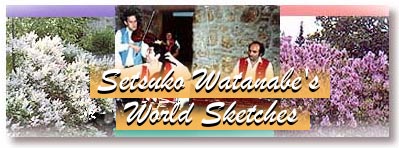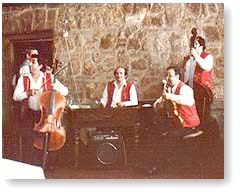
and the Great Hungarian Plain |

|
||||
|
1. Gypsy (Cigany) Music in Budapest
The best time to travel in eastern Europe is spring, when the lilacs are in full bloom. In eastern Europe, we can still see traditional culture- something which seems to have been lost long ago in other areas of the world. In particular, Budapest is a city which reminds the traveler of olden times and makes you feel at ease. It is the capital of Hungary and connects the Buda hills and Pest district, on opposite sides of the Danube, with a series of bridges. Known as the Paris of eastern Europe, it has an atmosphere of freedom and activity, and yet, an indescribable sadness lingers in the air. This sadness is the result perhaps of the many invasions, by Ottoman Turkey, Hapsburg, and others, and continuous destruction this land has suffered. Surviving the cold winter and blossoming wonderfully in the spring, the melancholy lilacs are well-suited to this city. The Hungarian people (Magyars) originally came from Asia, crossed the Ural and invaded this region at the end of the ninth century. Perhaps because of their Asian origins, they seem to have a certain affinity with the Japanese. Not only is the similarity between the two languages uncanny, but our emotional sensibilities are also very alike, making meeting someone for the first time like meeting an old friend.
At the top of Gellert Hill, while taking in the night view of Pest on the other side of the Danube, I hear the sound of violins, playing a ballad of dramatic melodies. Listening to the music conjures up thoughts of love in my mind, and drawn by it, I enter a nearby restaurant. There I see a Gypsy (Cigany) band playing the violin and cimbalom (a kind of xylophone) in the middle of their performance.
Gypsies, whose native land is said to be northern India, have created their own unique kind of music by bringing together many kinds of music which they gathered from all corners of the world during their migrations.
Many people have seen the beauty of Gypsy music. The nights in Budapest overflow with music. Next is The Great Hungarian Plain and the Chernobyl Nuclear Reactor Accident.
LINKS
Copyright1998 Setsuko Watanabe
|
- Continue -
- back to home -

